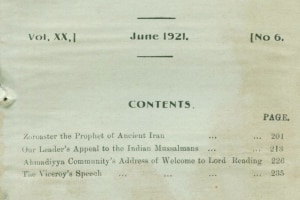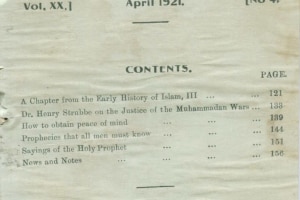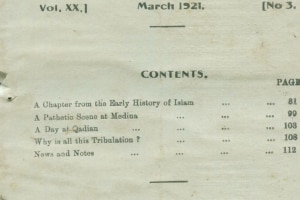
A Chapter from the Early History of Islam, V
The July 1921 edition of the Review of Religions was full of scholarly and faith-inspiring articles. The first article of the issue was the translation of an address given by His Holiness, Hazrat Mirza Bashir-ud-Din Mahmud Ahmad(ra), second Successor of the Promised Messiah(as), to the Martin Historical Society at the Islamia College Hall Lahore on the 26th of February 1919. It was an extremely significant lecture because it dealt with a particularly important era in the history of Islam. This address eloquently explained the causes of conflict and dissension amongst early Muslims. Hazrat Mirza Bashir-ud-Din Mahmud Ahmad(ra), provided a correct and accurate historical account of the conflicts which arose amongst early Muslims after the demise of the Holy Prophet(sa). Hazrat Mirza Bashir-ud-Din Mahmud Ahmad(ra) refuted various allegations levelled against the person of Hazrat Uthman(ra) and his companions. Some historians have claimed that conflicts of early Islam were the results of an alleged incompetence of Hazrat Uthman (ra), while others have claimed this to have been the result of a bitter power struggle between various companions of the Holy Prophet(sa). In this lecture, His Holiness(ra) countered both these notions with clear evidence and clarified that conflicts arose due to the conspiracies of the enemies of Islam. This lecture is now available in a book form.
Proof of the Existence of God
The next article is a highly learned piece arguing that order, harmony, regularity, coherence, and coordination seen in this universe is a powerful proof of the existence of God. The overwhelming patterns of order, harmony and regularity seen in the universe prove the existence of an ‘Intelligent Being’; this ‘Intelligence Being’, or God, is the primary cause of what we see today. The structure, process, and consistency seen in the universe, such as orbital movements of celestial bodies, precise laws governing the chemical composition, and complex geometric construction of crystals, are all crying out for a ‘Creative Intelligence’.
The author goes on to say that weighing, measuring, and numbering the various components of the universe requires enormous mathematical knowledge and research. Is it even conceivable that the universe, that takes so much wisdom to be understood, was created by a blind force wholly ignorant of intelligence, planning, and design? Without accepting the existence of a ‘Supreme Intelligence’ there can only be chaos and inconsistency. Belief in a “Divine Reason” is the only concept which brings rationality to the universal truths of the material world.
It is mentioned that no science has had more influence on man’s religious belief than the science of astronomy. In fact, the increase of astronomical knowledge contributed to the transition from polytheism to monotheism. The author gave the example of the perfect precision despite the immense vastness of the solar system as a rational explanation of the existence of the ‘First Cause’. In the field of chemistry, we see that the vast variety of visible substances can be reduced to a few constituents, summarised in the Periodic Table. All these elements have their own properties and would always deliver the same product if combined with different elements a certain proportion. The presence of a clear purpose, conceived and executed by a ‘Supreme Power’, can be the only reasonable explanation to the existence of a precise, structured, and cohesive chemical world. The coordination of the system of the atmosphere, which sustains every living being beneath it, is clear evidence of the existence of a supremely Profound and Accurate Mind. With regards to the sciences of geology and palaeontology, the history of rocks, light, air, moisture, land, and sea, all demonstrate that all physical forces are arranged and co-ordinated to produce a sustainable state of the universe. The same also resonates with biology, in which we find an elaborately adapted system of living beings and organs. The evidence of design and order in the exquisite creations of the eye and ear have been presented as clear evidence of ‘Designing Intelligence’.
Throughout the ages, poets and other philosophers have made their own speculations, all in awe of the perfect harmonious nature of creation, and its allusion to the existence of God. As with political economy, it is a natural inference from all the social stability and welfare that a supreme reason controls all human reasons. This same ‘Reasoning Power’ enables human beings to realise a purpose greater than any which they themselves could contemplate. Admiring the complex interaction between body and mind, Montesquieu, a famous political philosopher, and French judge, asks, ‘What can be more absurd, than to imagine that the blind fatalistic forces has produced intelligent beings?’ Where there is an intelligent action, there must be an intelligent being; however, we look at this universe, it leads us to God.
A Misunderstanding Removed
The next article is a letter to the civil and military gazette of Lahore titled: “A Misunderstanding Removed”. This article refuted the incorrectly represented view that the Ahmadiyya Muslim Community is advocating for the restoration of ‘Turkish’ (Ottoman) control over the Hejaz (Muslim holy land of the Arabian Peninsula, where Mecca and Medina situated). The misunderstanding arose because of misquoting of the point argued by the representative of the Ahmadiyya Muslim Community. There were rumours that Great Britain desired to reduce the King of Hejaz to a chieftain. Hazrat Musleh Maud(ra), advocated for the complete independence of the Hejaz in a pamphlet that has recently been published in English titled, “The Turkish Question”. It has been unequivocally declared in this letter that the Ahmadiyya Community desires an independent Hejaz, and failing that, Hejaz should be under Turkish rather than British control.
Success of Missionaries in Across the UK, US, and West Africa
Next in the July edition of the Review of Religions, there is news from the London mission that lectures at Hyde Park are proving successful. Christian missionaries seem to be taking a hostile attitude. The famed poet Rabindranath Tagore met with members of the Ahmadiyya Community and spoke at great length about how the advancement of Asia must begin from India, which was unfortunately becoming the first victim of the downfall of Asia owing to its religious differences. He also said that Islam alone could supply the common platform upon which the children of Asia could stand.
The success of the American mission too was made mention of, as people are starting to accept Islam. The success of Mufti Sahib is helping Americans to accept Islam was perceived as a cause for concern by Christian missionaries. Local newspapers report that when he is on the streets preaching the message of Islam, the Ahmadi Muslim missionary in United States Mufti Sahib wears his distinct green turban and green flowing robes, symbolic of his native India. On Eid of June 1921, there was a parade in Detroit, led by Mufti Sahib. This happened after only being in the country for several months. Mufti Sahib with his humble background established the Al-Sadiq Mosque, one of the first mosques in the USA, which still stands to this day.
News of the advancement of Ahmadiyyat in West Africa was recently received, where some 4000 Fanti Muslims accepted Islam Ahmadiyyat. Maulvi Abdur Rahim Nayyar Sahib arrived in West Africa on the 19th of February 1921, and he was warmly greeted upon his arrival in Sierra Leone. Two days after his arrival, he met with Muslims and Christians. He was very educated. During debates, Christians were no match for him. He continued to dispel misconceptions wherever he went. Success was also reported in the missions of Arabia, where 78 people accepted Islam Ahmadiyyat and a further 15 travelled to Hejaz for pilgrimage.
About the Author: Professor Amtul Razzaq Carmichael MD, MEd, FRCS (Gen Surg.), MBBS, is a consultant. She qualified in 1987 with gold medals for academic excellence and undertook her surgical training at major teaching hospitals in London, Edinburgh, and Philadelphia. She has authored many articles for major peer-reviewed scientific journals. She is a senior member of The Review of Religions Editorial Board as well as Assistant Manager.




Add Comment